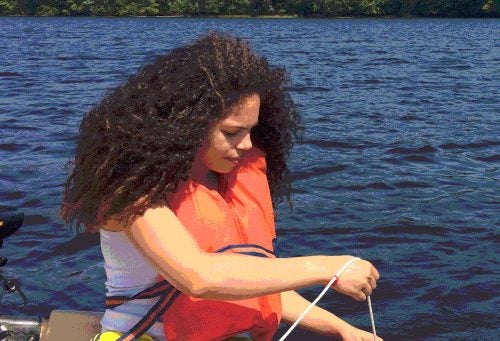URI Watershed Watch seeks volunteers to monitor ponds, streams, coast
Last year’s intense summer affected water quality in ponds, lakes, rivers and streams throughout Rhode Island – for the better in some places, for the worse in others. Continuing weather extremes, like the wetter-than-normal fall and winter are likely to impact sites this year too.
According to Elizabeth Herron, director of the University
of Rhode Island’s Watershed Watch program, extreme weather can be challenging
for the hundreds of volunteer water quality monitors participating in the
program, and the places they monitor.
“The drought actually improved water quality at some
sites because pollutants weren’t being washed into the water, while the drought
made other sites worse because pollutants weren’t being washed out by big rain
events,” said Herron. “The warm weather also seemed to help drive harmful algal
blooms, with some lasting well into the fall.”
Wet weather this winter may lead to small problems in the
coming year.
For more 35 years, the Watershed Watch program has worked
with local communities to track many of the factors that affect water quality
in local water bodies and determine their current conditions. Thanks to the
program, much more is known today about how land use, seasonal weather
patterns, climate change and other factors affect local waters in good and bad
ways. Here is a link to a list and map showing the communities
where Watershed Watch conducts monitoring.
The program, one of the longest running citizen science projects in Rhode Island, is now seeking additional volunteers to conduct weekly or biweekly monitoring from May to October. For the first time since the pandemic forced training solely online, in-person classroom training for new Watershed Watch volunteers will be offered the evening of Wednesday, March 22 and repeated the morning of Saturday, April 1. A video session will still be available for those who can’t make it or would rather not sit in a classroom with others.
Volunteers are matched to a specific site that they will
be responsible for monitoring. Every week or two typically on a day of their
choice, they monitor and test for a number of water quality indicators. On
several designated dates, the volunteers collect water samples that are brought
to URI’s Kingston campus to be analyzed for nutrients, acidity and bacteria.
Among the many water bodies needing volunteer monitors is
Meshantucket Pond in Cranston, and Sand and Gorton Ponds in Warwick. These
require a means to get out onto the water, a canoe, kayak or other small boat.
But many other sites don’t.
Many volunteers work in teams to share their monitoring
duties, said Herron. Monitoring can also be an enjoyable family activity for
parents and their children, and teens can use it to gain required community
service hours.
Ponds, lakes and some saltwater sites are monitored at
their deepest point, so access to a boat, canoe or kayak is necessary. But few
river and stream sites need a boat. Other sites are monitored from the shore or
by wading in.
Watershed Watch is sponsored by URI Cooperative Extension
in the College of the Environment and Life Sciences, the Rhode Island
Department of Environmental Management, and about 48 local organizations and
communities.
For more information or to register for the training
sessions, contact Elizabeth Herron at 401-874-4552 or at eherron@uri.edu. Visit
the program’s website at web.uri.edu/watershedwatch for detailed information
about the program and its list of 2023 monitoring locations.
